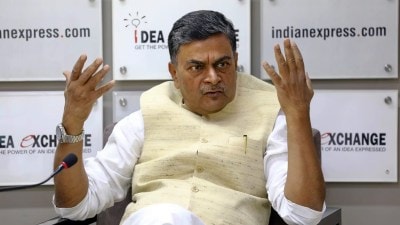Indian nonprofits have a jugaad sensibility when it comes to tech: Donald Lobo, Founder, Project Tech4Dev
Donald Lobo spoke to indianexpress.com on the challenges nonprofits face in adopting tech-based solutions, the journey of Project Tech4Dev in India, and how his products are being used.
 Donald Lobo spoke to indianexpress.com on the challenges nonprofits face in adopting tech-based solutions, the journey of Project Tech4Dev in India, and how his products are being used. (Photo: Donald Lobo)
Donald Lobo spoke to indianexpress.com on the challenges nonprofits face in adopting tech-based solutions, the journey of Project Tech4Dev in India, and how his products are being used. (Photo: Donald Lobo)Donald Lobo is the founder of Project Tech4Dev, a US-based nonprofit helping nonprofits in India and the global south build and scale their tech-centric solutions.
Project Tech4Dev has built a slew of products and solutions for the Indian nonprofit sector. One of them is Glific, a WhatsApp chatbot builder which helps nonprofits connect with beneficiaries, share information, collect feedback, and analyse the interaction to gain insights into pain points and further streamline their programmes.
They also run Dalgo, a data platform for nonprofits using open-source software elements to help in data ingestion, storage, transformation, and visualisation.
Their Fractional CXO programme helps nonprofits meet their tech and data needs, by allotting a seasoned tech professional to the nonprofit for a period of six months to a year, helping them understand and evaluate their requirements and find solutions.
Donald Lobo spoke to indianexpress.com on the challenges nonprofits face in adopting tech-based solutions, the journey of Project Tech4Dev in India, and how his products are being used. Edited excerpts:
Venkatesh Kannaiah: Can you tell us about your Project Tech4Dev; its journey and its goals?
Donald Lobo: We started looking at India 5-6 years ago and began pilots with around eight nonprofit partners. Our philosophy was that tech was not the only solution, but it can definitely help nonprofits scale up their activities. While we were in the first phase of our journey in India, Covid stuck and most nonprofits in India moved on to helping people on the ground, whether it be urban poor, rural poor, or migrant workers. Tech was not an important component at that time. Later, during the second phase of our journey, we onboarded quite a few partners onto our platforms.
We are working with 150 nonprofit partners in India as of now, through our four products or platforms. Glific is a WhatsApp chatbot, Dalgo is a data ingestion, storage and visualisation platform and Avni is a data collection platform. We also understand the importance of building a tech ecosystem for nonprofits and work with software providers, design firms, nonprofit firms and others to spread the word around.
Project Tech4Dev is registered in the US and in India, it works as a part of Dasra, a nonprofit.
Venkatesh Kannaiah: How tech-savvy are nonprofits?
Donald Lobo: It is like any other industry and everything else in life. It is a bell curve. There are those who do amazing work with tech, there is a middle, and those who do very poorly with tech. Among those who do very well with tech in our cohort are the following nonprofits.
There is Avanti Fellows, a nonprofit providing underprivileged high school students free test preparation programmes, mentorship and career services that help them place into top-tier science and technology colleges across India. There is Rocket Learning, a pioneering nonprofit transforming Early Childhood Development (ECD) across India. They create communities of Anganwadi workers and parents, both in-person and digitally, using accessible technology and engaging content.
There is Noora Health which works to improve health outcomes by equipping family caregivers with the skills they need, making them an integral part of healthcare delivery, and there is SNEHA a non-profit in Mumbai that works with women, children and families in communities; and with public health and safety systems.
I see an element of jugaad in the way many nonprofits use tech and stretch their resources, the innovative ways in which they work to maximise their reach and effectiveness. Some might not be using a lot of tech, but they are certainly using it in creative ways.
There are also those at the other end of the spectrum – without sufficient funding or resources and who have not been able to invest in tech.
Venkatesh Kannaiah: Can you tell us about the challenges nonprofits face when they use tech or tech tools on the ground?
Donald Lobo: When we interact with nonprofits, we rarely speak about what tech can do for them. We ask them about their problems, processes, and systems, and then introduce them to tech solutions. Good tech cannot make bad processes better. We cannot resolve the problems of processes or systems or operational issues. We can only provide support to the existing process and systems and we discourage nonprofits from looking at tech as some silver bullet.
However, as we get on the ground, we find that there are some nonprofits which are working on the ground and use manual processes in an excellent manner. For example, in the health outreach sector the paper and pencil method of data collection is working fine, and using tech would help them to make their work betterBut should they need to stop everything and overhaul their tech systems? The answer is No.
Nonprofits need to see tech not as a one-time investment but as a recurring cost, which they should budget for. Our tools are not free for nonprofits, it is very moderately priced with high end features, but we want nonprofits to see value and budget for the same. Also, there are enterprise solutions in similar areas that are not tuned for nonprofit work, either in terms of expertise, customisation or the service that we provide.
Venkatesh Kannaiah: Can you tell us about your product Glific and some interesting ways your partners are using it for social impact?
Donald Lobo: Glific is a low-code, conversational builder primarily using the WhatsApp platform. It helps nonprofits to communicate and receive feedback from their stakeholders or beneficiaries in a better manner. It does not require substantive tech or data skills on the part of the nonprofit, and is designed to run with minimum intervention. There are various use cases for the product in the nonprofit space from education to health to civic engagement.
We have Quest Alliance which has used it in the education sphere, where it used the app to distribute reading material and collect detailed feedback from students who had used it for material and subjects which were not part of their core curriculum. In the health sector, it is used by nonprofits to reach beneficiaries and patients with advice from community health workers and the product also allows for audio transcription.
One of the nonprofits working in the Bengaluru area, Reap Benefit used it for youth community engagement. During Covid, they had worked on a community basis to provide and match hospital beds to patients using this platform. Now they work on helping citizens reach out to their local elected representatives in a constructive manner.
We are also working on making these platforms more user-friendly. Now it is enabled in various languages. One can raise a question in Hindi in audio, it would get automatically translated into English, search the database for the correct answer, translate the same into Hindi again and give the information to the user or the beneficiary who raised the question in an audio format. And it is fully automated.
This voice feature works with major Indian languages and we are now enabling it with many more languages with the help of Bhashini.
Venkatesh Kannaiah: Tell us about your Dalgo Data platform and Avni data collection platform and the ways it is being used by your partners.
Donald Lobo: There are interesting use cases for our platform. One of the projects we are working on with the ATE Chandra Foundation is where they are desilting water bodies in drought-prone districts across the country, and distributing the silt to the farmers in the region, partly to allow the water bodies to hold large amounts of water during the next rainy season and help farmers with fertile soil. This project seamlessly uses our data collection system, the data ingestion and data visualisation platform and our communication platform for communicating with farmers and other stakeholders.
One of the nonprofits, SNEHA, which works in the community health sector, uses our data collection and data storage products seamlessly. They alert their community health workers on what questions to ask from the patients or beneficiaries and use the app to collect the data and connect to a database where it is analysed and insights are gleaned.
Venkatesh Kannaiah: How does your Fractional CXO programme work?
Donald Lobo: Fractional CXO is a programme wherein we hire top quality tech resources and place them for a nominal fee within nonprofits for a period of nine months to a year. It is a bit tough for nonprofits to find the right tech personnel and hire them. Either the hurdle could be in terms of the cost involved or the flexibility needed. We resolve this by hiring the person and placing him or her in a nonprofit for a nominal fee. The same person could work with two nonprofits too, and the cost burden could be shared. Nonprofits like Janaagraha in Bengaluru and SNEHA in Mumbai are putting this to good use.
Venkatesh Kannaiah: What is your forecast for tech usage by nonprofits? Are there any instances where nonprofits have used tech in a purposeful manner?
Donald Lobo: I am impressed with the way some Indian nonprofits have started using tech in their activities in an interesting manner. SNEHA, a nonprofit organisation that works with women, children and families in the area of public health, is using our applications to launch various pilots and experiments in the data and tech sphere.
This is enough to show that one does not need to be a techie to drive a tech-enabled intervention.
There is Avanti Fellows which works in the higher education sphere and uses tech and data in an interesting manner. By 2027, Avanti seeks to enable 100,000 students from low-income backgrounds to gain admission into top-tier STEM colleges, leading to stable careers and the ability to transform their life trajectories.
There is Reap Benefit from Bengaluru which uses tech to connect with communities and youth and help engage with the government and lawmakers in a constructive manner.
There is also Lend A Hand India, which prepares youth for employment and entrepreneurship opportunities by working at the intersection of education and livelihood.
My reading on what the Indian nonprofit use of tech can improve upon is in the field of fundraising and volunteering. Large nonprofits in the developed economies are using tech in an amazing way to raise funds, and we need to catch up in India. In some economies, the amount nonprofits get from small donors is much more than from foundations. The same is the case with volunteering. There is a huge potential for tech to bring new volunteers into the segment, though some have begun doing it in India, there is much more that could be done.
The next challenge for nonprofits in India would be the multiplicity of languages and scaling up. Both of these would require tech and tech-based solutions to make an impact.








